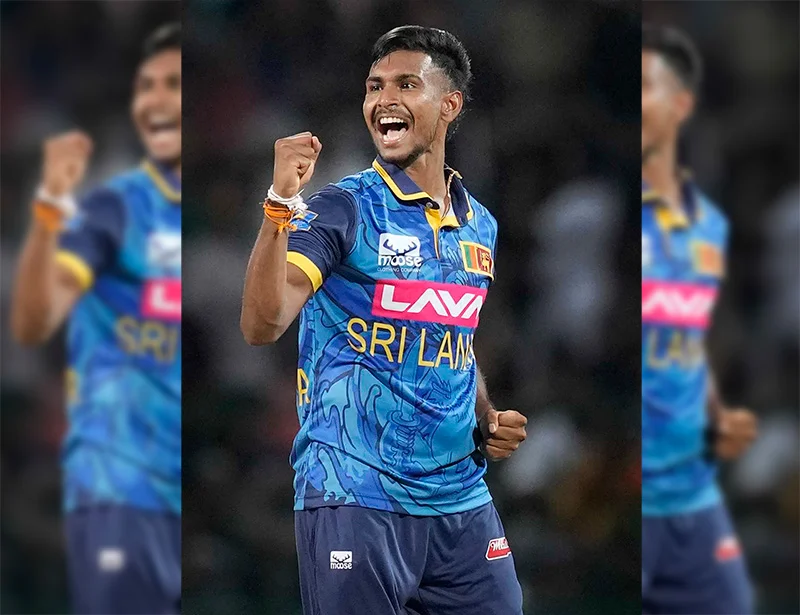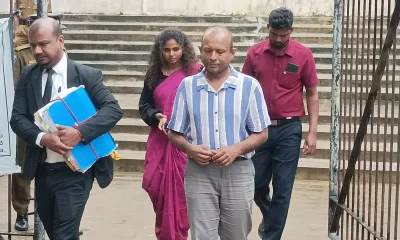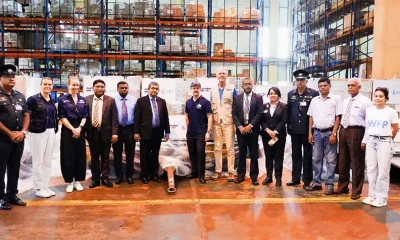Sports
When the referee gets bigger than the game…

by Rajitha Ratwatte
The 100th All Black vs Springbok test match was played in Townsville to a sold-out stadium of 25,000 spectators. The referee from the UK Luke Peirce. The All Blacks started in style with Codie Taylor in the number two jersey making a great break off a long passage of play from the kick-off and sending Will Jordan over line mid-right. Jordie Barret converted 7–0 to the Kiwis in the first three minutes of the game. Two minutes later the Springboks triggered off what was going to be their game plan throughout the game with a high spiralling kick into the opposition 22 resulting in George Bridge being unable to collect clean and Sbu Nkosi (no 14) capitalising on the mistake and dotting down mid-right. Handre Pollard was unable to convert, and the score read 7–5 inside the first six minutes. That was it as far as running rugby and try-scoring went, as is to be expected when the South Africans’ call the shots and play to their preferences. The game was slowed down deliberately, and the referee probably used to this style of play from his Northern hemisphere background either chose not to react or simply didn’t do anything about the medical staff coming on almost after every single set-piece. The blood bin seemed to be a thing of the past and this combined with extremely slow forming up for lineouts was exactly how the ‘Boks wanted it to be.
The rest of the half consisted of a series of penalties mostly against the Kiwis for discernible and sometimes unfathomable reasons. The AB’s ball-handling left much to be desired and the ‘Bok forwards pack definitely had the edge in both the set pieces and in loose play. A yellow card dished out to the South African try-scorer almost on half time for what should in the opinion of many, been a penalty try as well the only notable feature in a very scrappy and largely forgettable half. The lead changed twice, and the Kiwis were unable to capitalize in being a man up for six minutes in the first half. The halftime score read 13–11 to the Blacks.
The second half saw the South African go into the lead on penalties again 13–14 until the 56th minute when the ABs finally took a kickable penalty having turned down two earlier and went ahead by 16–14. The Boks’ kicked one more 16–17 and the Blacks retaliated 19–17. The lead had changed six times in the game so far and the Black bench came on with Quentin Tupaea was able to force a turnover penalty in the closing minutes of the game and Jordie Barret stepped up and into the history books by slotting the kick from the extreme left of the field and around 40 meters out. A slim victory 19-17 but all you can expect when you allow the Springboks to play their brand of rugby!
This victory ensures a win in this year’s rugby championship to the All Blacks with a game to spare and retention of the freedom cup which is awarded for the series against South Africa. The Kiwis definitely missed some of their stars who had chosen to stay at home for personal family reasons and it is hoped that the likes of Mo’uanga, Smith, and Whitelock join the team for the forthcoming European tours.
When a team that has been holding on to the world champion of rugby union title for two years depending on a game plan that consists of high kicks and relying on the mistakes of the opposition and the vagaries of the referee to win, it does not bode well for the game. Rugby union may soon follow in the footsteps of Test cricket, into oblivion as a popular spectator sport.
The second game of the double header was the Australian Wallabies hosting the Argentinean Pumas. A definitely improved Australian team never looked in trouble against the Pumas and even on the few occasions that the Pumas looked dangerous their discipline let them down. The Australians owe a lot to their Pacifica players led by Taniela Tupou in the front row, Valetini at number eight and backs Samu Karevi and Marika Korombeiti, who have brought a new and exciting dimension to their game.
The final score was 27–8 to the Australians. Three goals (Korombeiti, Karevi and Kalloway) and two penalty conversions to one try from the Argentinian skipper Julian Motoya and a penalty.
supersubsports@gmail.com
Sports
Former Sri Lanka captain D. S. de Silva passes away at 83

Former Sri Lanka cricketer D. S. de Silva has passed away in London on Monday following a brief illness. He was 83.
A stalwart from the game’s formative years in the island, de Silva was part of Sri Lanka’s XI for their inaugural Test in 1982 against England. A year later, with injuries sidelining Duleep Mendis and Roy Dias, de Silva was handed the captaincy for the tour of New Zealand, a late call-up that came after he had already crossed his 40th birthday.
A classical leg-spinner with a cultured approach, de Silva was a familiar name in Ceylon colours long before Test status arrived, operating tirelessly in an era when opportunities were few and recognition scarcer still.
He featured in both the 1975 and 1979 World Cups, back when Sri Lanka were still associate members, and played a decisive role in the famous upset of India in the 1979 tournament, claiming three wickets in a win that proved a watershed moment on the road to Test recognition.
De Silva was also among the rare professionals of his generation, having plied his trade in English league cricket, broadening his horizons at a time when overseas exposure for Sri Lankans was the exception rather than the norm.
After hanging up his boots, de Silva continued to serve the game as a selector and coach, leaving his imprint on the next generation. He coached Sri Lanka to the Under-19 World Cup final, nurturing young talent with the same patience he once showed at the crease and at the bowling mark.
He later moved into administration, heading Sri Lanka Cricket from 2009 to 2011 as chairman of the Interim Committee. During his tenure, the Hambantota and Pallekele International Cricket Stadiums were built ahead of the 2011 World Cup, which Sri Lanka co-hosted.
De Silva’s passing marks the end of an era, as one of the quiet architects of Sri Lanka’s rise in world cricket finally leaves the field.
Sports
National Short Track Athletic Championship on January 3

The second edition of the National Short Track Athletics Championships will be held at the 200 metres track of the Sugathadasa Stadium on January 3, 2026.
The event scheduled for a 1.00 pm start is limited to a few track and field events generally held at indoor stadiums.
It will be the first track and field event of the year and will be held when Sri Lanka Athletics is governed under a convening committee.
Sri Lanka Athletics is without an elected body after Sports Ministry’s attempt to conduct the election of office bearers under new sports regulation ended up in a fauxpass.
Now the Sports Ministry is scheduled to conduct a Special General Meeting next week where an Election Committee will be reappointed to hold the election of office bearers.
The short track meet will be held under the observation of the convening committee.
The events to be held at the meet are (Men & Women) 60m, 400m, 800m, 1500m, 3000m, 60m, Hurdles, High Jump, Long Jump, TripleJump and Shot Put.
The 60m, 60m Hurdles and 400m events will be held as heats and finals, where the best times will qualify for the finals.
Other track events will be held as time finals (Final A/ Final B).
All the field events will have only 3+1 rounds.
(RF)
Sports
Cameron Green becomes most expensive overseas player; uncapped Indians go big

Australian allrounder Cameron Green has been bought by Kolkata Knight Riders (KKR) for INR 25.20 crore ($2.8 million approx.), making him the third-most expensive player sold at an IPL auction, and the most expensive overseas player ever.
KKR also bought the second-most expensive player at the IPL 2026 auction – Sri Lankan fast bowler Matheesha Pathirana for INR 18 crore ($1.97 million approx.).
The record for the most expensive uncapped Indian player was also broken, with 20-year-old left-arm spin allrounder Prashant Neer and 19-year-old wicketkeeper Kartik Sharma going to Chennai Super Kings (CSK) for a staggering INR 14.2 crore each, breaking Avesh Khan’s INR 10 crore mark in the 2022 auction. Jammu and Kashmir fast bowler Auqib Nabi also had a big payday, with Delhi Capitals buying him for INR 8.4 crore.
KKR, who began the auction with the largest purse of INR 64.3 crore, had to stave off competition for Green from CSK, who had the second-highest purse of INR 43.4 crore. The bidding, though, began with Mumbai Indians (MI), who had to drop out of the race quickly because they had a purse of only INR 2.75 crore. Rajasthan Royals (RR), who had a purse of INR 16.05 crore, took the bid as far as INR 13.40 crore before exiting, at which point CSK joined the bidding against KKR.
Green’s bid took more than ten minutes to complete, and he ranks behind Rishabh Pant (INR 27 crore) and Shreyas Iyer (INR 26.75 crore) on the list of most expensive IPL players. The most expensive overseas players before Green were Mitchell Starc (INR 24.75 crore) and Pat Cummins (INR 20.50 crore). Green, however, will get only INR 18 crore due to a maximum salary cap imposed by the IPL on overseas players at mini-auctions. The bid amount in excess of INR 18 crore (INR 7.2 crore) will go to the BCCI for player welfare.
Green first played the IPL in 2023, when MI bought him for INR 17.5 crore. He scored 452 runs at a strike rate of 160.28, and picked up six wickets. MI then traded Green to RCB a year later for the same price. He scored 255 runs for RCB at a strike rate of 143.25, and took ten wickets. Green did not register for the mega auction ahead of IPL 2025 because he was returning from a back injury.
Green was one of only two players sold from the first set of batters on Tuesday, along with South Africa batter David Miller, who went to Delhi Capitals (DC) at his base price of INR 2 crore. Jake-Fraser McGurk, Prithvi Shaw, Devon Conway and Sarfaraz Khan were unsold.
The lukewarm bidding continued into the second set of allrounders, with only two of seven players sold. Lucknow Super Giants (LSG) bought Sri Lanka’s Wanidu Hasaranga at his base price of INR 2 crore. Venkat Iyer, who had been bought by KKR for INR 23.75 crore in the IPL 2025 auction, was sold to Royal Challengers Bengaluru (RCB) for INR 7 crore. Liam Livingstone, Rachin Ravindra, Gus Atkinson, Wiaan Mulder and Deepak Hooda were unsold in the first set of allrounders.
There was more action in the first set of wicketkeepers, with MI buying South Africa’s Quinton de Kock, DC buying England’s Ben Duckett, and KKR buying New Zealand’s Finn Allen – all at their base prices. CSK, who began the auction with the second-largest purse, did not buy a player from the first three sets.
CSK did not bid for Pathirana, who they had released at a price of INR 13 crore after IPL 2025. The demand for Pathirana began with DC and LSG, and once the bid reached INR 15.6 crore, DC dropped out considering they had a purse of INR 17.8 crore. KKR entered the bidding and priced out LSG, who had a purse of INR 20.95 crore, at INR 18 crore. Having missed out on Pathirana, LSG immediately bought South African quick Anrich Nortje at his base price of INR 2 crore.
RCB’s second buy at the auction was New Zealand fast bowler Jacob Duffy (INR 2 crore), who could slot in as back-up for Josh Hazlewood.
CSK did bid for legspinner Ravi Bishnoi, but stopped once the price reached INR 6 crore. RR and SRH then bid for Bishnoi, and he was eventually bought by RR for INR 7.2 crore. Akeal Hosein, the West Indies left-arm spinner, was eventually CSK’s first buy at the auction, at his base price of INR 2 crore.
Only 12 out of 40 players in the first six sets were sold.
Players bought at auction
KKR : Cameron Green, Finn Allen, Matheesha Pathirana, Tejasvi Dahiya, Kartik Tyagi
LSG: Wanindu Hasaranga, Anrich Nortje, Mukul Choudhary, Naman Tiwari
DC: David Miller, Ben Duckett, Auqib Nabi
RCB:Venkatesh Iyer, Jacob Duffy
MI:Quinton de Kock
RR:Ravi Bishnoi, Sushant Mishra, Yash Raj Punja, Vignesh Puthur
CSK:Akeal Hosein, Kartik Sharma, Prashant Veer
GT:Ashok Sharma
PBKS:
SRH: Shivang Kumar
(Cricinfo)
-

 Business6 days ago
Business6 days agoCabinet approves establishment of two 50 MW wind power stations in Mullikulum, Mannar region
-

 News6 days ago
News6 days agoGota ordered to give court evidence of life threats
-

 Features6 days ago
Features6 days agoCliff and Hank recreate golden era of ‘The Young Ones’
-

 Features6 days ago
Features6 days agoSri Lanka and Global Climate Emergency: Lessons of Cyclone Ditwah
-

 Latest News7 days ago
Latest News7 days agoSri Lanka squad named for ACC Men’s U19 Asia Cup
-

 Editorial6 days ago
Editorial6 days agoExperience vs. Inexperience
-

 News6 days ago
News6 days agoWFP scales up its emergency response in Sri Lanka
-

 News6 days ago
News6 days agoSpecial programme to clear debris in Biyagama













